5.5 EXPRESSIONISM-FURTHER DEVELOPMENTS
Expressionism Develops in Two Major Regions
As discussed earlier in this chapter, Expressionists sought to develop an emotionally powerful style that rejected naturalistic imagery in favor of emotional impact.
Here is a reminder of the general expectations that we may have about Expressionism. Keep these in mind as you begin to distinguish between the varied directions in which the style developed.
- The focus is psychological rather than natural.
- Emotional states are often presented in contrasting and even dissident colors or in stark black and white.
- Metaphor is more important than any specific situation.
- Shapes are distorted to amplify the emotion being evoked.
- Art works are often experimental in form or media.
- Visual arts, music and literature all embraced and used expressionism as a way of capturing the human element in the industrial revolution, which often seemed to leave humans behind, in terms of importance.
- Rather than describing physical or spiritual events, expressionism tended to describe reactions to those events.
- These excursions through the human mind created a wide variety of expressionistic experiences but tended to focus on strong and often terrifying emotional experiences.
- Rather than creating pictures and experiences relating to the outside world, expressionists created paths into the world within the human.
The French Fauvists
The Paris Salon of 1905 introduced the world to a group of French painters that became known as The Fauvists (The Wild Beasts). This was the reaction of critics to the French Expressionist style at its debut.
This movement set the tone for future developments in Dadaism, Futurism and Surrealism among others. Unlike most of the other art movements, however, Expressionism was not founded on a single agreed upon formula. These formulas were generally expressed in the form of manifestos. Many of these artists did know each other and some even painted together. They no doubt discussed their work with together but they never claimed to be part of a movement. All were, however, influenced by earlier styles, particularly that of Van Gogh and Gauguin. They used the same vibratingly bright colors and incorporated the loose brush work seen in these two earlier artists. From Gauguin they also borrowed his idea of colored shadows. From Seurat they took a divided touch and the constructive value of untouched canvas. During this same period that Cubists were exploring a more intellectualized approach to painting, the Fauvists were primarily experimenting with color. The timing was perfect as new pigments and binders were being developed that allowed for long lasting bright colors.
Henri Matisse
Henri Matisse (1869-1954) is the most famous of the Fauvists. This is a bit odd as he was one of the more conservative painters associated with the style. Notice the similarities and the differences between this painting of dancers by Gauguin and the same subject painted by Matisse.
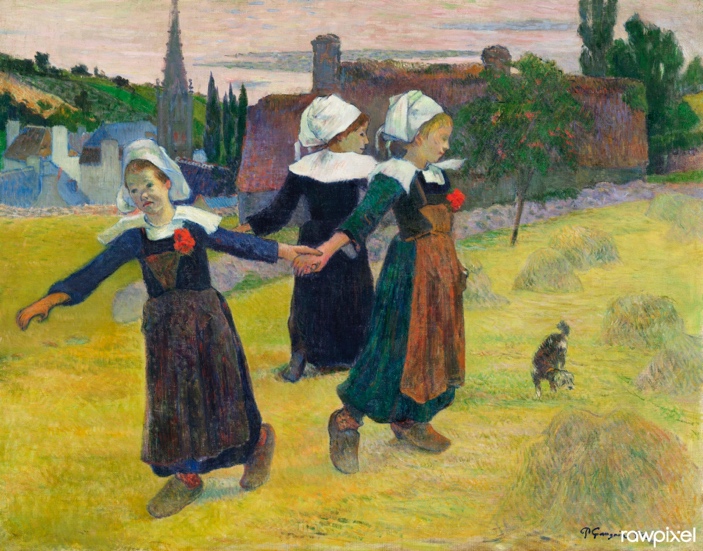
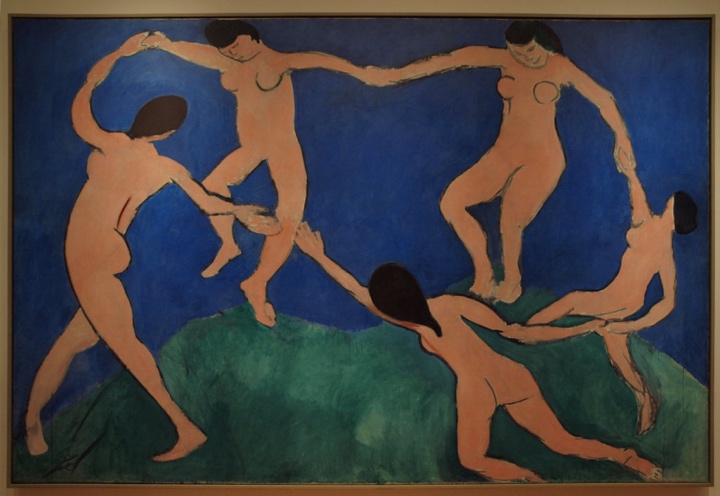
Notice how the background in the painting by Matisse is vague and unimportant, other than the bright blue that helps the orange dancers stand out. While the “ground is a filed of green, it reveals no sense of depth other than the overlap of the dancing figures. It is the dynamic movement that is captured by Matisse, rather than the moment in time that is captured by Gauguin. While Gauguin presents dancers, Matisse presents the spirit of dance.
Below is an interior painted by Matisse in 1911. Note how the artist uses bright patterns that may represent wallpaper or carpet, it is impossible to tell which is intended. The decorative designs flatten the picture as they are both below and behind the table. There are many other intentional departures from the traditional rules of painting. Matisse places a window at the edge of the painting, leading the viewer’s eyes out of the picture. There seems to be several viewpoints seen of the table. The linear perspective created by the tabletop becoming smaller as it moves away from the viewer is counteracted by the placement of the eggplants, which seem to lay at the edge, neither on nor off the surface of the table. Because the tablecloth does not fall at the edge of the table, we see the eggplants from above, whereas the view of the plate with the pears is frontal. Matisse is playing with ideas initiated by Cézanne as well as those of Munch and Gauguin. Although overlap indicates that the folding screen behind the table is also behind the mirror, it is reflected in the mirror.
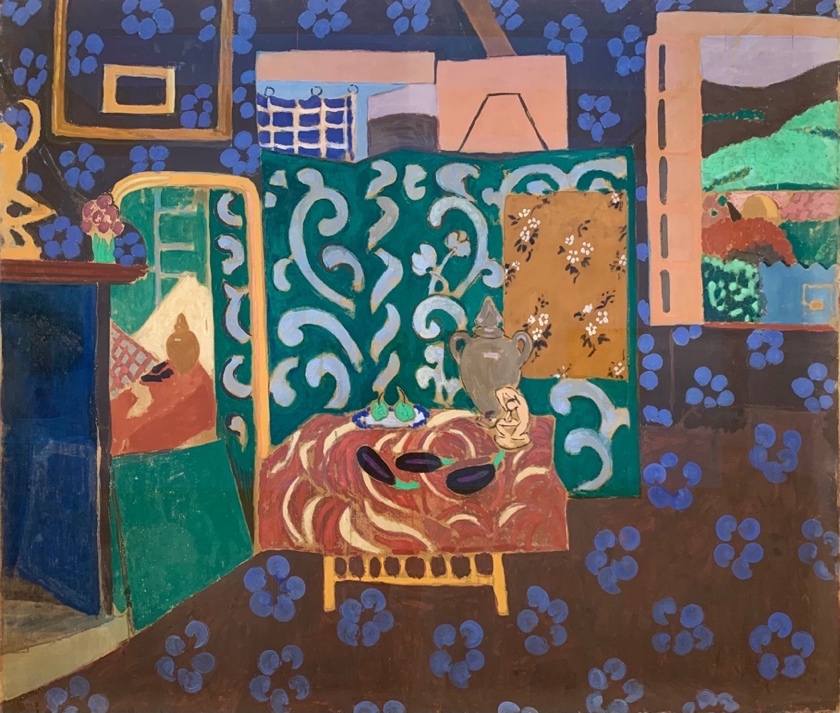
For more on the application of Fauvist ideas click the hyperlinks:
A Beginner’s Guide to Fauvism article
If you receive an error with the link above, use the following link https://www.khanacademy.org/humanities/art-1010/early-abstraction/fauvism-matisse/a/a-beginners-guide-to-fauvism
Matisse, Luxury, Calmand Voluptuous 3:26
If you receive an error with the link above, use the following link https://www.khanacademy.org/humanities/art-1010/early-abstraction/fauvism-matisse/v/matisse-luxe-calme-et-volupt-1904
If you receive an error with the link above, use the following link https://www.khanacademy.org/humanities/art-1010/early-abstraction/fauvism-matisse/v/henri-matisse-the-red-studio-1911
Matisse, Dance 1 article
If you receive an error with the link above, use the following link https://www.khanacademy.org/humanities/art-1010/early-abstraction/fauvism-matisse/a/matisse-dance-i
In the images below, look for the ideas found in most Expressionistic endeavors while also noticing how these paintings are distinctly Fauvist. Can you tell who the artists are borrowing ideas from?
Common tendencies of the Fauvists:
- Bright, even violent use of color
- Loose brushwork
- Often drawings made from paint (critics considered many of these works to be unfinished sketches).
- Canvas often peeks through
- The shadows are filled with color
- Representational images are of little interest
- There may be several perspectives used in the painting
- There are often color and patterns that seem more decorative than naturalistic
- Any sense of depth is subservient to colors and shapes
- The focus of subject matter is on reactions to experiences rather than on capturing a moment in time
- Draw on “primitive” influences (although seldom to the degree that Neo-primitivists did)
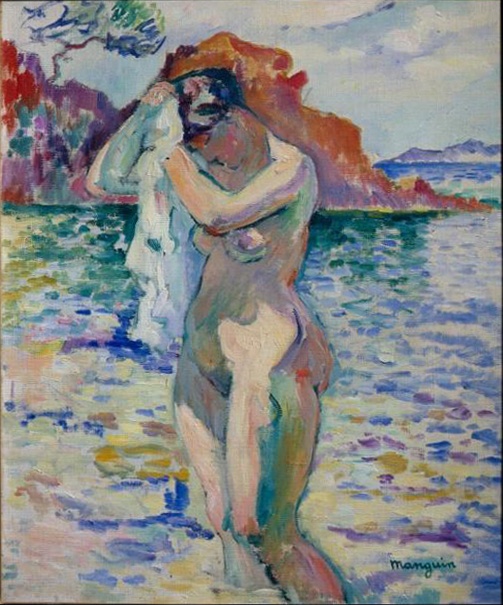
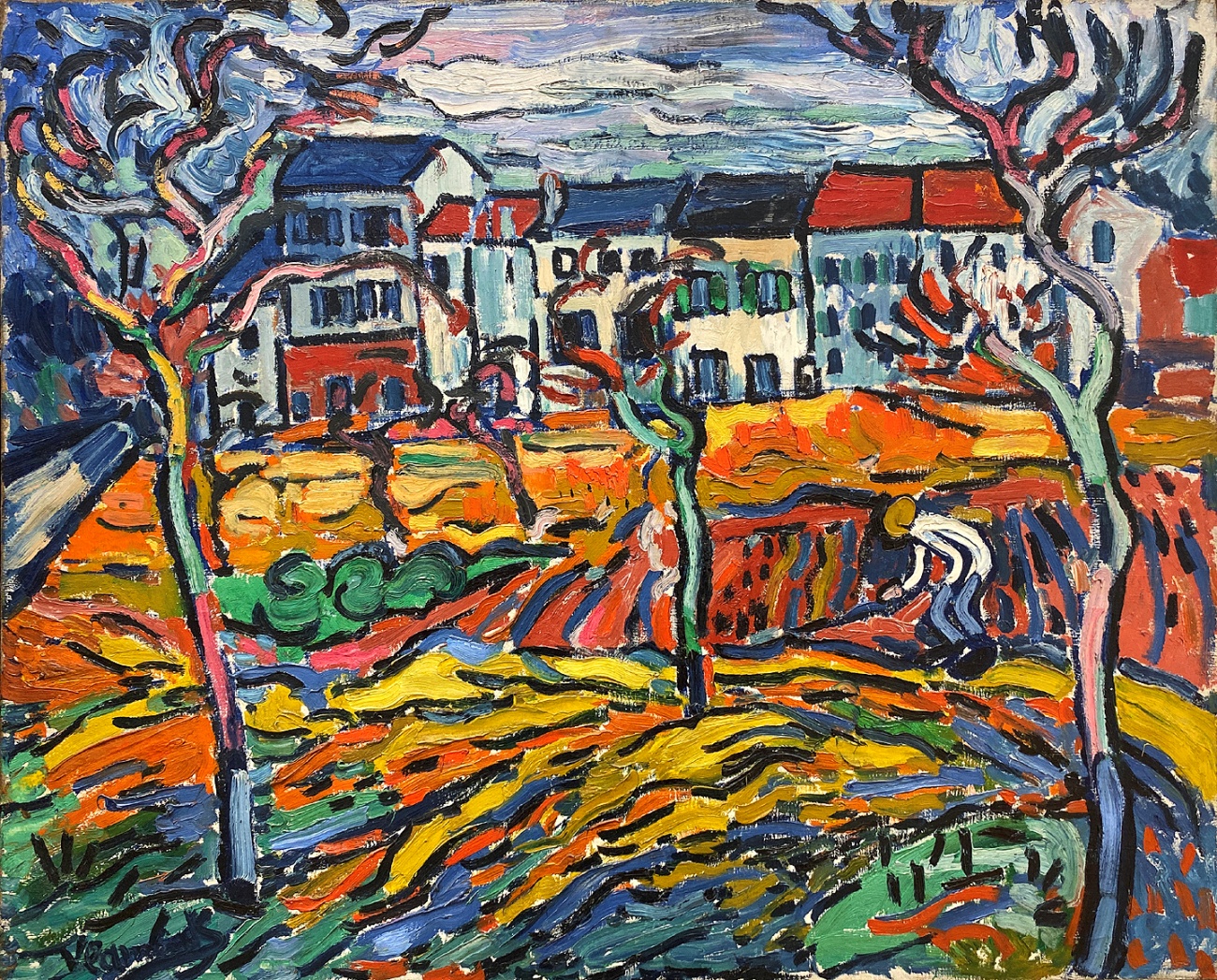
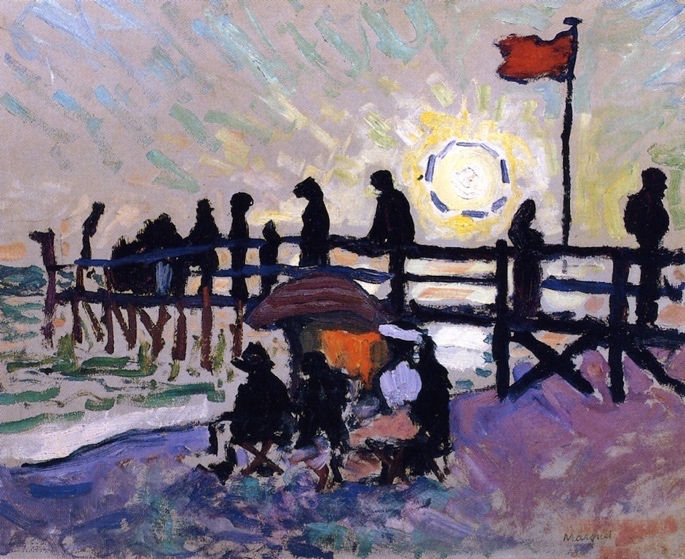
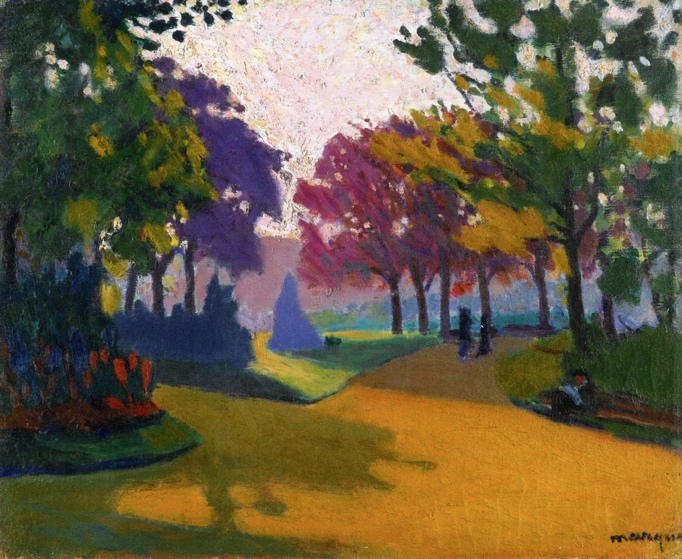
German Expressionism, Die Brücke(The Bridge)
German Expressionism before World War I was primarily developed by two different groups. Die Brücke (The Bridge) was an association of painters that lived in Dresden. In 1905 they chose this name because they hoped to build or become a bridge that would connect them to other Expressionistic artists and to the future.
Die Brücke, unlike the Fauvists did have a sort of manifesto, although it was not formal. Kirchner had this quote included in the introductory broadsheet for the first Die Brücke exposition. “With faith in progress and in a new generation of creators and spectators we call together all youth. As youth we carry the future and want to create for ourselves freedom of life and of movement against the long-established older forces.”10
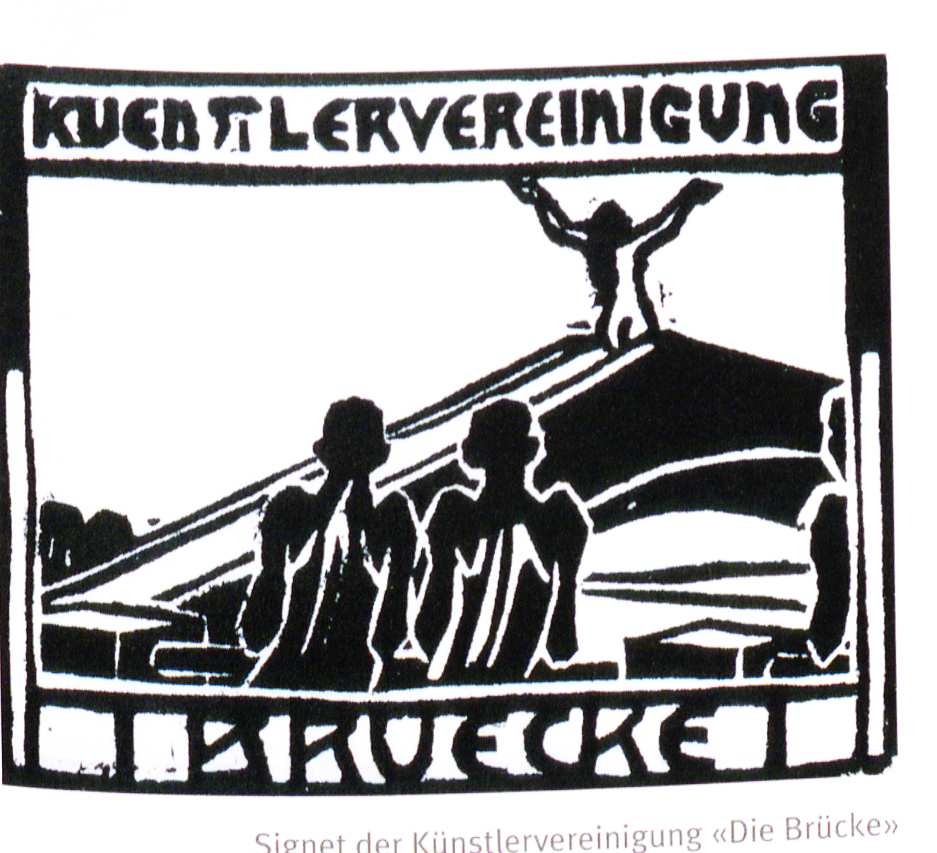
One of the major ways that The Bridge differed from the Fauvists is their interest in the spiritual aspects often displayed in the Symbolist and Romantic styles. That interest can be seen in the common use of the woodcut method of printmaking that was the norm in the middle-ages.
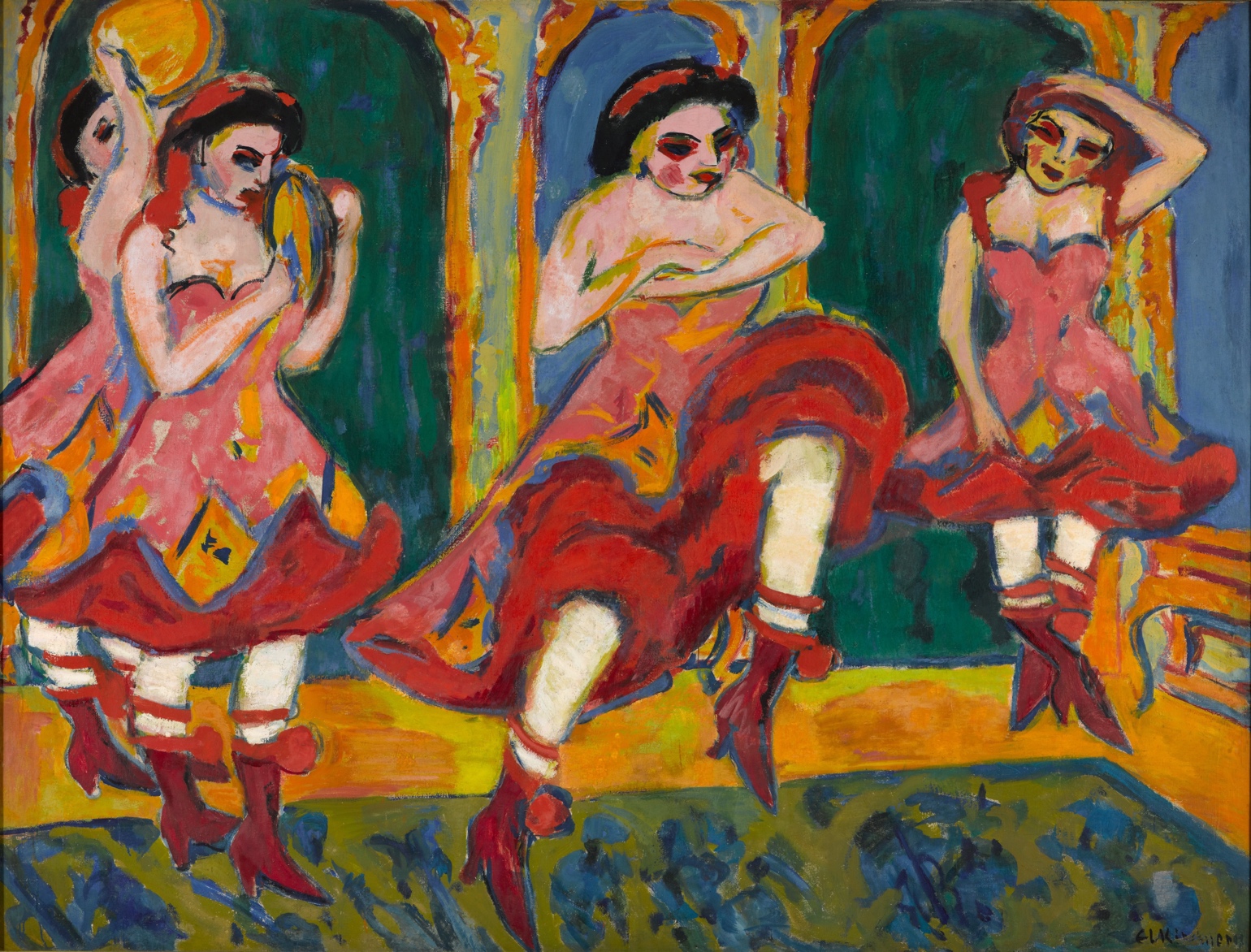
Kirchner often painted dancers. His experience with use of the “primitive” convinced him that dancing put people in touch with their basic urges. Above is a painting of can-can dancers. Can-can dances happened in music halls, the 1800s version of nightclubs, and served as peep shows. The girls raised their skirts and swished them about, revealing their many layered undergarments and the garters that held up their stockings. At least in this case, Kirchner clearly had a point!
Below is another of Kirchner’s paintings. Note the emaciated condition of the men crowded into the shower. It is an unpleasant image of skinny, hungry men crowed into a shower while watched by a fully dressed officer. No one seems to have extra body fat. The men are not presented as individuals but as a part of a large group who all seem to look alike. Most have ribs showing as if they could use a good meal. Artillery Men in the Shower is an apt metaphor for the lack of privacy and often dire conditions that accompanied urbanization. It also serves as a metaphor for the brutality of the war that had begun a year earlier. The war would bring many hardships and many changes to the people and to the world of art. Subjects would change, and the brutality and devastation that the war caused to most Germans would change people’s attitudes toward many things.
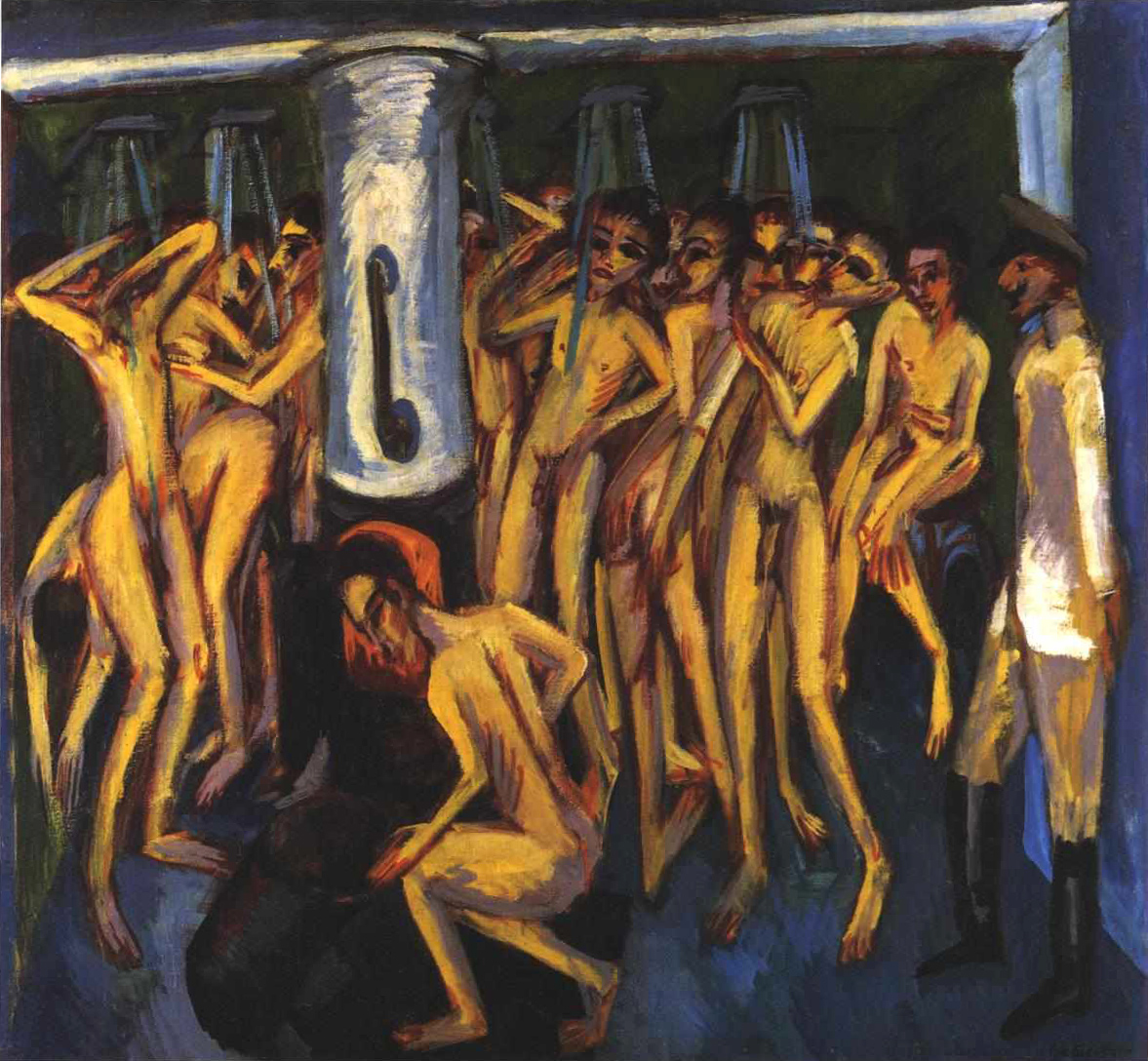
Notice that Kirchner uses intense hues of blue and orange, opposites on the color wheel. The only exceptions to this palette are the orange red of the fire and the red accents on the bodies of the emaciated men. The red lines that indicate ribs showing also read as slashes or cuts. The use of black, normally avoided in earlier painting styles, serves to make the color pop out at the viewer by contrast. White is also used sparingly to draw attention to the stove where the shower water is heated and to the coat of the officer who stands by dutifully, and unenthusiastically.
For a deeper look at the work of the DieBrücke German Expressionists click the hyperlinks below:
Ernst Ludwig Kirchner, Street Berlin 2:21
If you receive an error with the link above, use the following link https://www.khanacademy.org/humanities/art-1010/early-abstraction/expressionism1/v/kirchner-street-berlin?modal=1
Emil Nolde, Young Couple, 1913 2:16
If you receive an error with the link above, use the following link https://www.khanacademy.org/humanities/art-1010/early-abstraction/expressionism1/v/moma-nolde-youngcouple?modal=1

The coming of war to Germany in 1914 would affect many things and would disillusion many people. Eventually these shifts ended the Die Brücke and changed the arts world-wide. Before moving on to how worldwide events affected the arts, however, we will look at another German Expressionist group, Der Blaue Reiter (The Blue Rider).
German Expressionism, Der Blaue Reiter (The Blue Rider)
In 1909 a group of avant-garde (favoring new, experimental or unusual ideas) artists formed the informal group, Neue Kunstler Vereiningung (New Artist Association or NKV) in Munich. Members included Wassily Kandinsky, Franz Marc, Paul Klee, August Macke, Gabriele Munter and Marianne von Werefkin. In 1911, Kandinsky and Marc broke with the NKV. In December of that year, the two painters held the first exhibition under the name, Der Blaue Reiter.Both artists also acted as sole editors in the collection of essays,Almanach Der Blaue Reiter (Blue Rider Almanac) first published in May 1912.15
The magazine was originally intended to be a yearly publication. Although that did not happen, it had an impact. The “almanac” contained an eclectic grouping of ideas in the form of a dozen essays and illustrations of the work of many artists. Kirchner, Van Gogh, Cezanne, and Picasso are there alongside images of African Statues, Chinese ink paintings, German folk art and Renaissance wood cuts.
“One of the editors of the book, the Russian artist Vasily Kandinsky, wrote of Der Blaue Reiter’s intent, ‘We aim to show by means of the variety of forms represented how the inner wishes of the artist are embodied.’”16 In this simple statement a paradigm shift is made evident. Artists were clearly moving away from the traditional forms of imitation of the outer world and searching for ways to present inner truths.
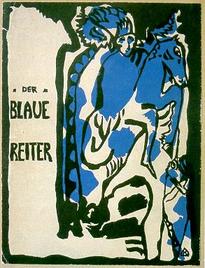
The name of the group does not seem to have any deep meaning on its own, except perhaps as a metaphor. Cramer and Grant share that, Kandinsky flippantly said that Marc liked horses and he liked riders and they both liked blue.The metaphor came in to play in who the rider was. Saint George, the dragon-slayer rides the blue horse. The article goes on to say,”The crude, almost childlike simplicity of the cover art for the Almanac, along with its Christian medieval imagery of the blue rider as Saint George, is a visual emblem of two of the groups’ main themes: primitivism and spirituality.”18
Other artists were drawn to The Blue Rider Group. Eventually Gabriele Münter, Auguste Macke, and Alexej von Jawlensky had also become members. Much like the Impressionists before them, banding together allowed them Riders to create the opportunities they had been denied by the well-established salons and galleries. Their exhibitions not only presented the group’s work but also included ancient woodcuts and other art that had been identified as “primitive.” They redefined ancient religious images, foreign paintings and even German folk art to the status of fine art. In many cases the art was done by untrained artists, opening another door through which many would later follow.
The works in the exhibitions had something in common. The artists that had created them rejected or were unaware of the tradition of scientific naturalism that emerged during the European Renaissance. This was The Blue Rider’s way of reconnecting with the spiritual aspects of art. There was a feeling that the “primitive” approach would reveal higher spiritual aims than had been seen in “high” art for some time, if ever.
Der Blaue Reiter, Vasily Kandinsky(1866-1944)
Vasily Kandinsky was a Russian born artist who moved around Europe as circumstances required. Kandinsky worked in several mediums, wood cut, watercolor and oil were among them. The artist’s life was spent searching for the spiritual in art. During this search, he belonged to several associations of artists who had similar goals. He also taught at the Bauhaus, a progressive German school and at another progressive school, Phalanx, where he met his lover and protégé, Gabriele Münter. Their association lasted for twelve years and is documented by his many paintings of her. Kandisnky’s teaching, his art associations and his publishing spread his ideas around the world.
This search for the spiritual through art filled his work with themes of renewal and metamorphosis. His art was generally positive, bright and unpredictable. He experimented with multiple art forms including painting, poetry, essay writing and stage composition. He also experimented with many different painting mediums and surfaces. He worked in oil, watercolor, gouache, tempra and probably varied mixtures of these mediums. He painted on canvas, board, wood, plywood, glass, compressed board and others that he devised himself.19
This experimentation was encouraging to other artists who wished to deny tradition and redefine art. In an article published by the Guggenheim the author tells us, “His was not a fixed path from representation to abstraction, but rather a circular passage traversing persistent themes centered around the pursuit of one dominant ideal: the impulse for spiritual expression. This, what Kandinsky called the artist’s “inner necessity,” remained the guiding principle through the periodic redefinitions of his life and work.”20
As early as 1912 in Kandinsky’sImprovisation series, we see works that at first sight seem to be pure abstraction. To discover why that is not considered to be the case, view this video analysis of a Kandinsky painting from that series.
Kandinsky, Improvisation 28 (second version), 1912 5:15
If you receive an error with the link above, use the following link https://www.khanacademy.org/humanities/ap-art-history/later-europe-and-americas/modernity-ap/v/kandinsky-improv28
Vasily Kandinsky “Klänge (Sounds)” 2:12
If you receive an error with the link above, use the following link https://www.khanacademy.org/humanities/art-1010/early-abstraction/expressionism1/v/kandinsky-sounds
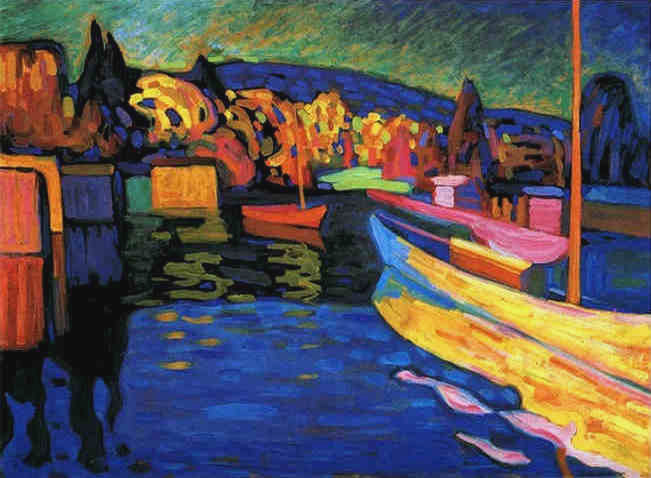
Above is one of Kandinsky’s more representative works from early in his career. Notice that even though there is a recognizable subject, the image is more emotional than realistic. His love for blue is clearly seen in this painting.
In the image below Kandinsky uses a woodcut to present one of his favorite subjects, riders on horses. In true Kandinsky fashion he seems to borrow the subject from a medieval work, the Bayeux tapestry. The odd positioning of the rear horse and the stylized tree evoke memories of the folk art tapestry, made to honor the Christian King, William the Conqueror.
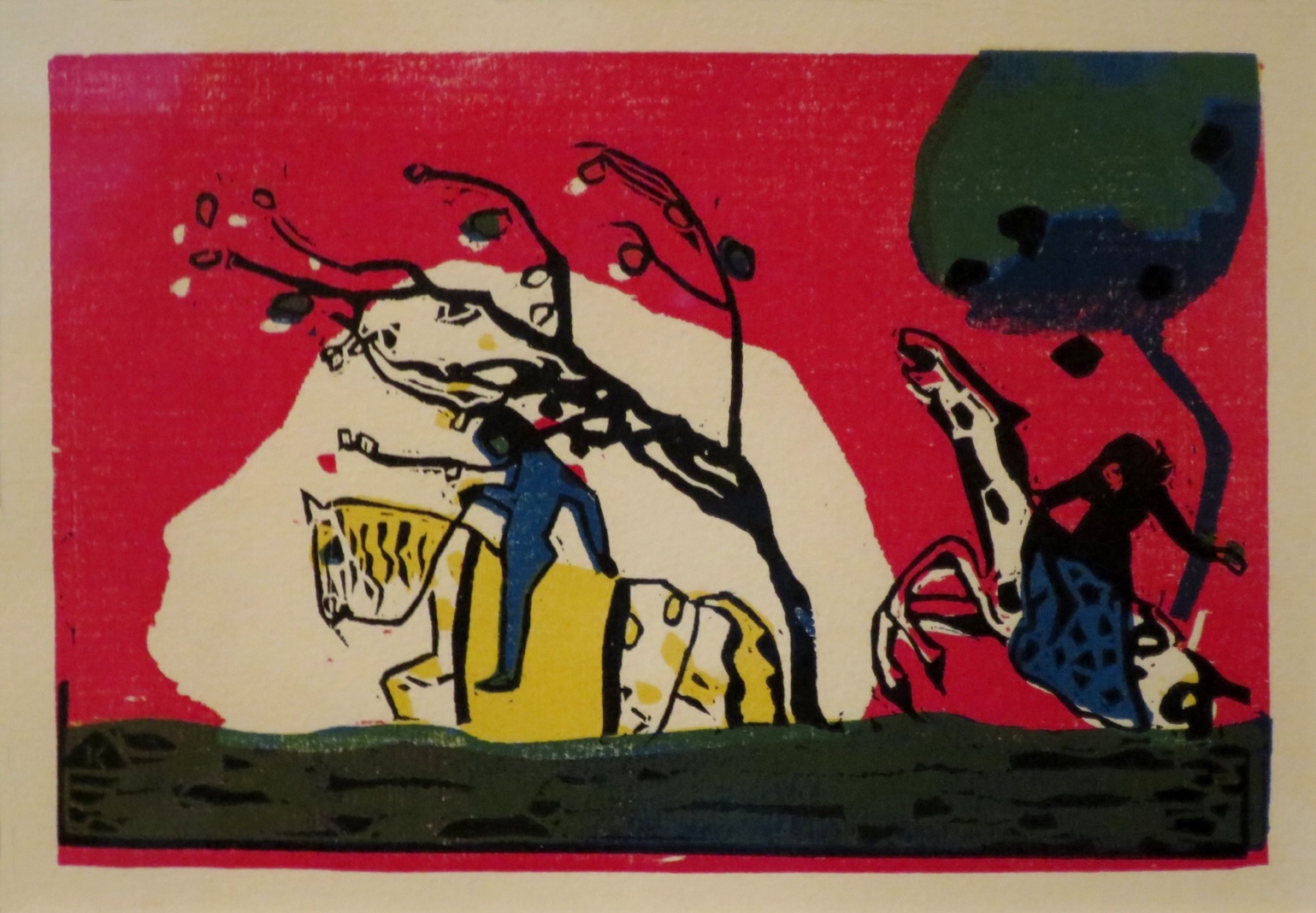
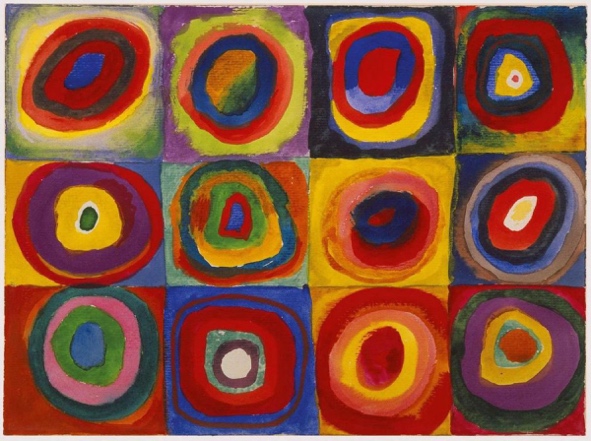

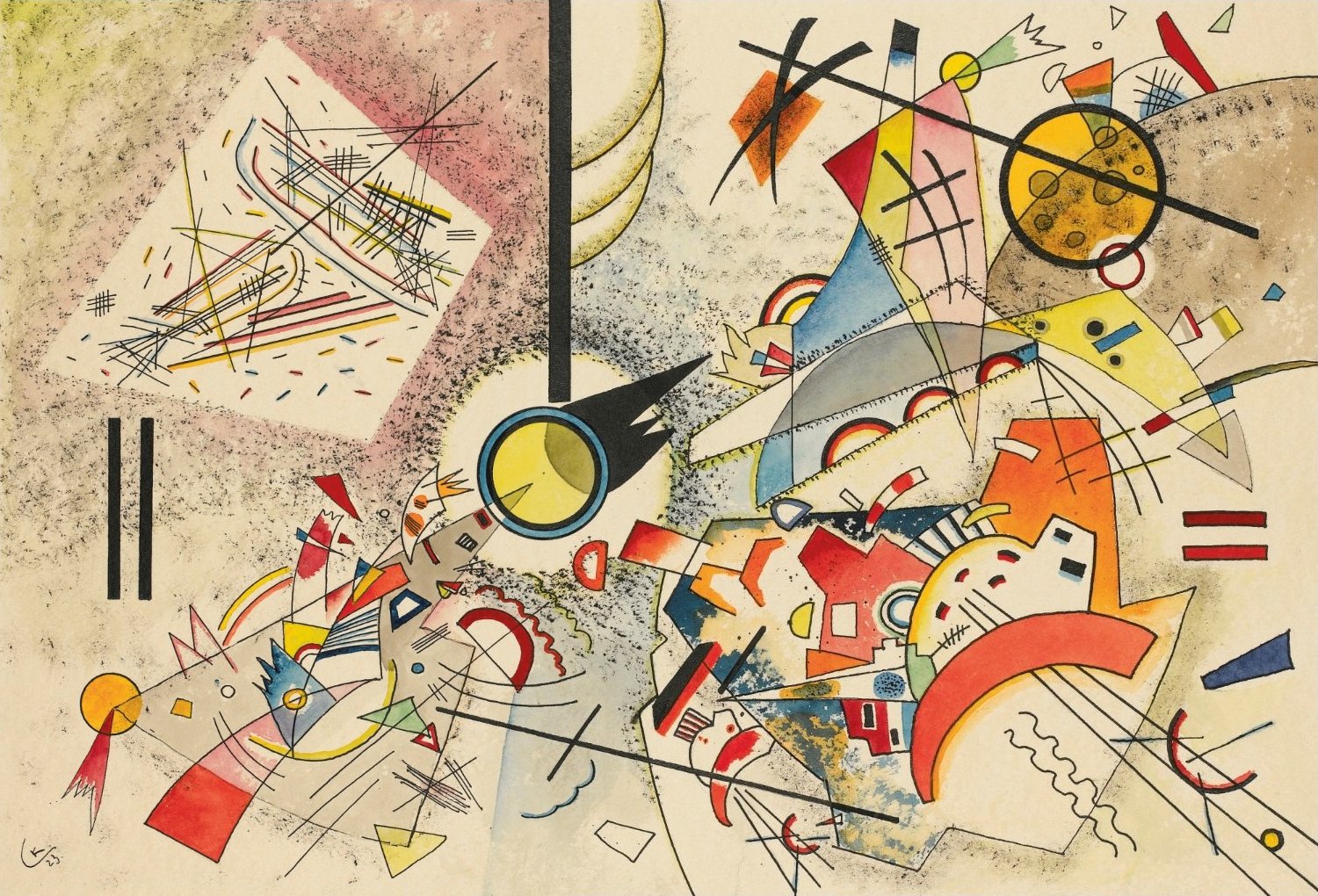
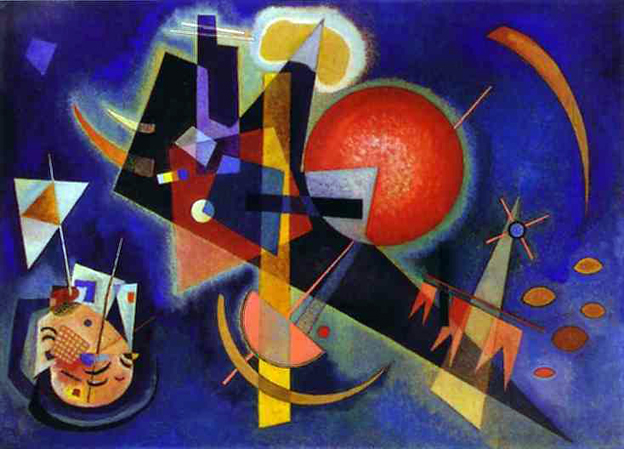
Der Blaue Reiter, Franz Marc
Franz Marc (1880-1916), who according to Kandinsky also loved blue, was clearly drawn to animals. He was particularly fond of painting horses. Please read the brief but excellent article provided by Kahn academy to understand what Marc meant when he called for the “animalization of art.”
Franz Marc and the animalization of art. Article (MUST READ). If you receive an error with the link above, use the following link https://www.khanacademy.org/humanities/art-1010/early-abstraction/expressionism1/a/franz-marc-and-the-animalization-of-art
Note that like Kandinsky, Marc paints in bright colors and experiments with his approach. He even fragments some images in an almost Cubist way, but that never overshadows the emotional or spiritual content of his work. Here are a few additional images for your pleasure. The painting below is filled with tension, which is amplified by the black fragmentation. This painting shows the influence of the Picasso and Cezanne on Marc’s work.
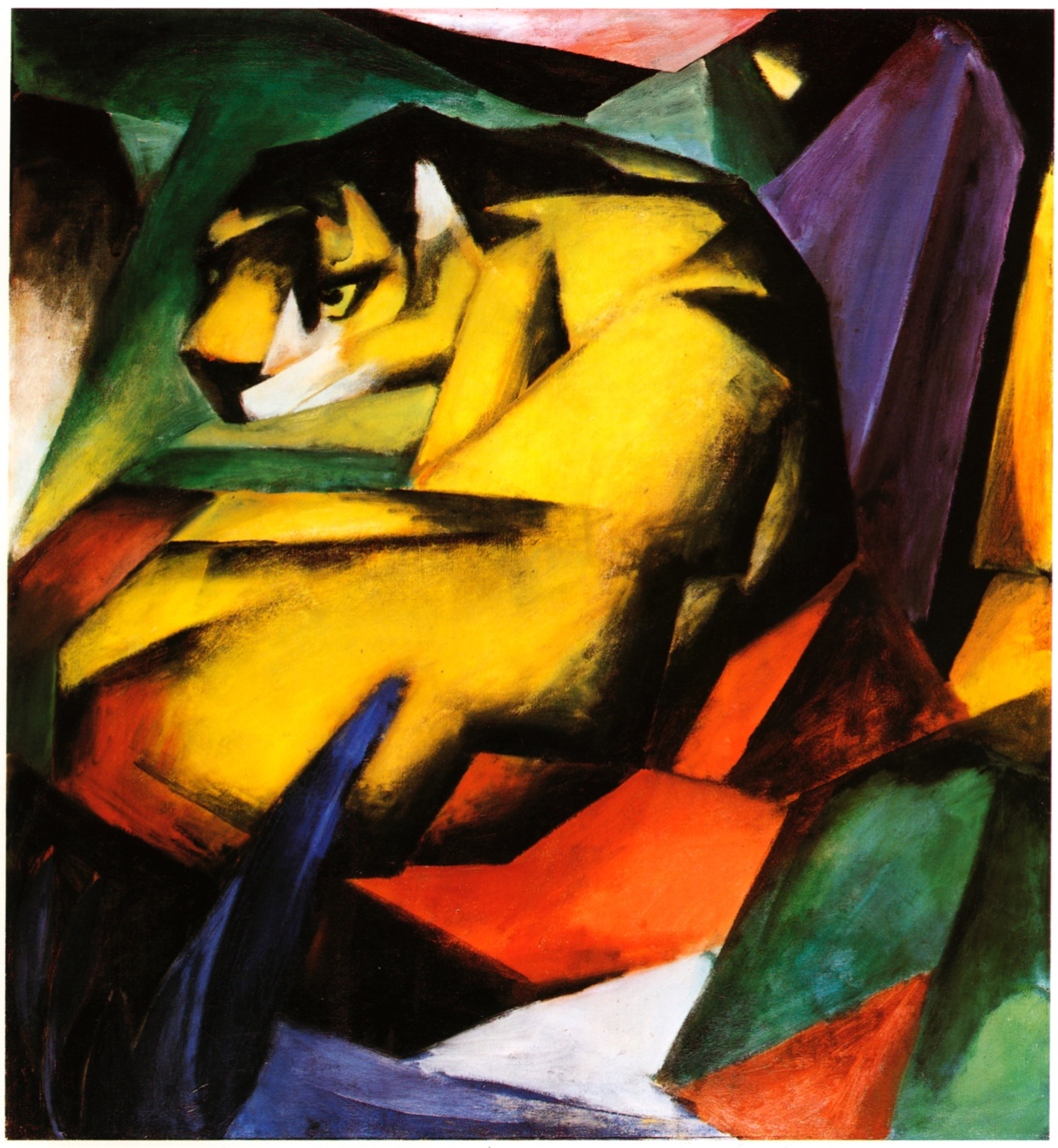
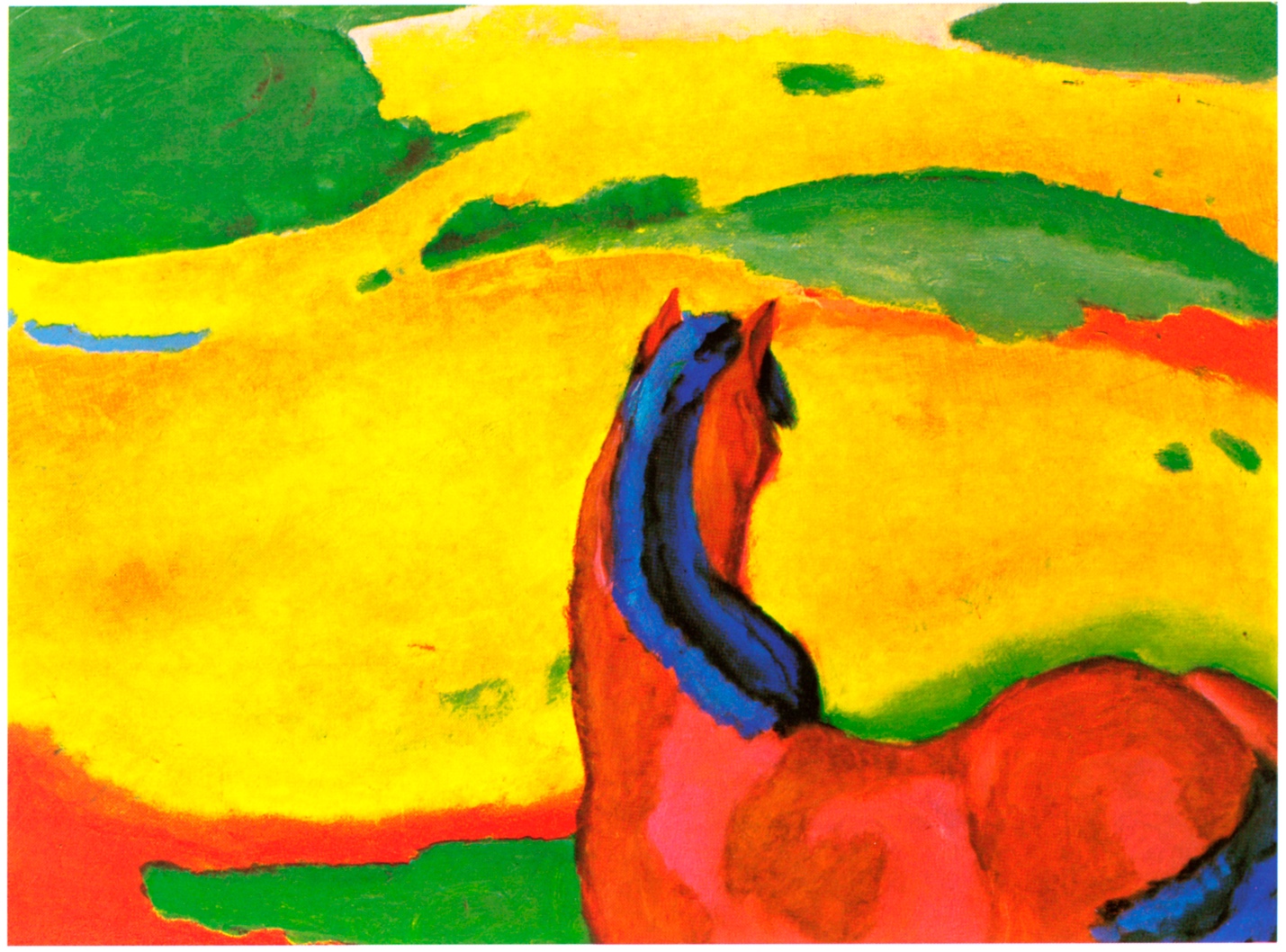
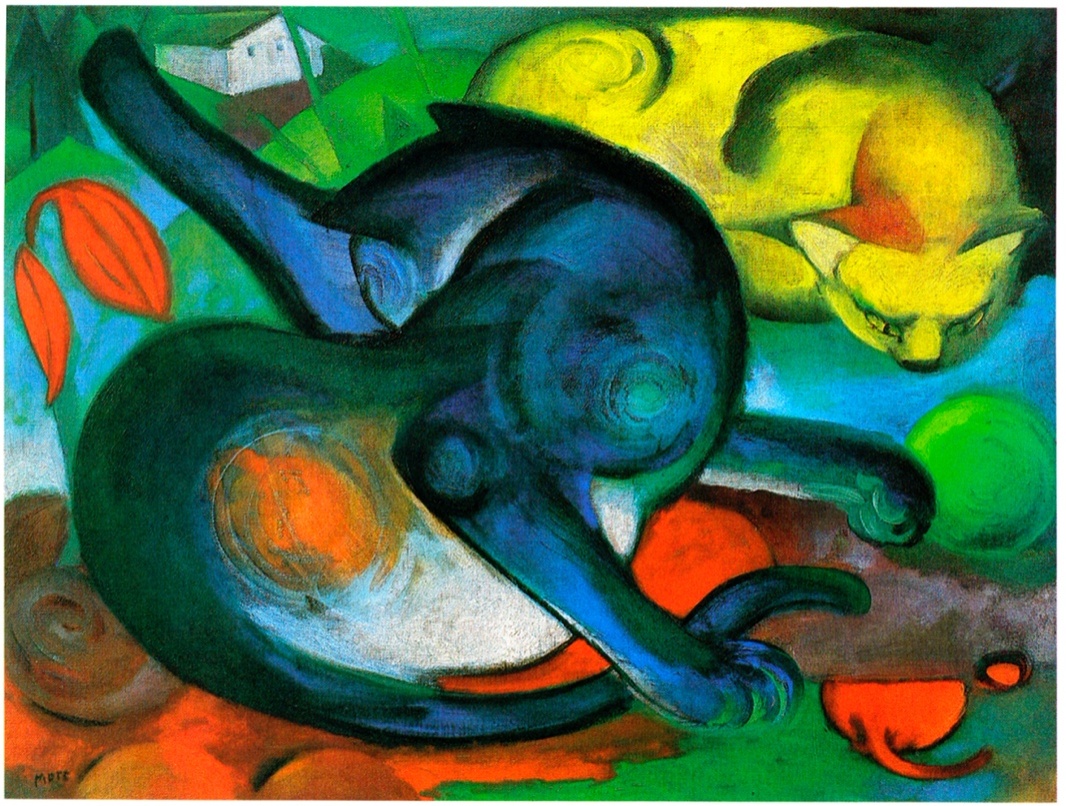
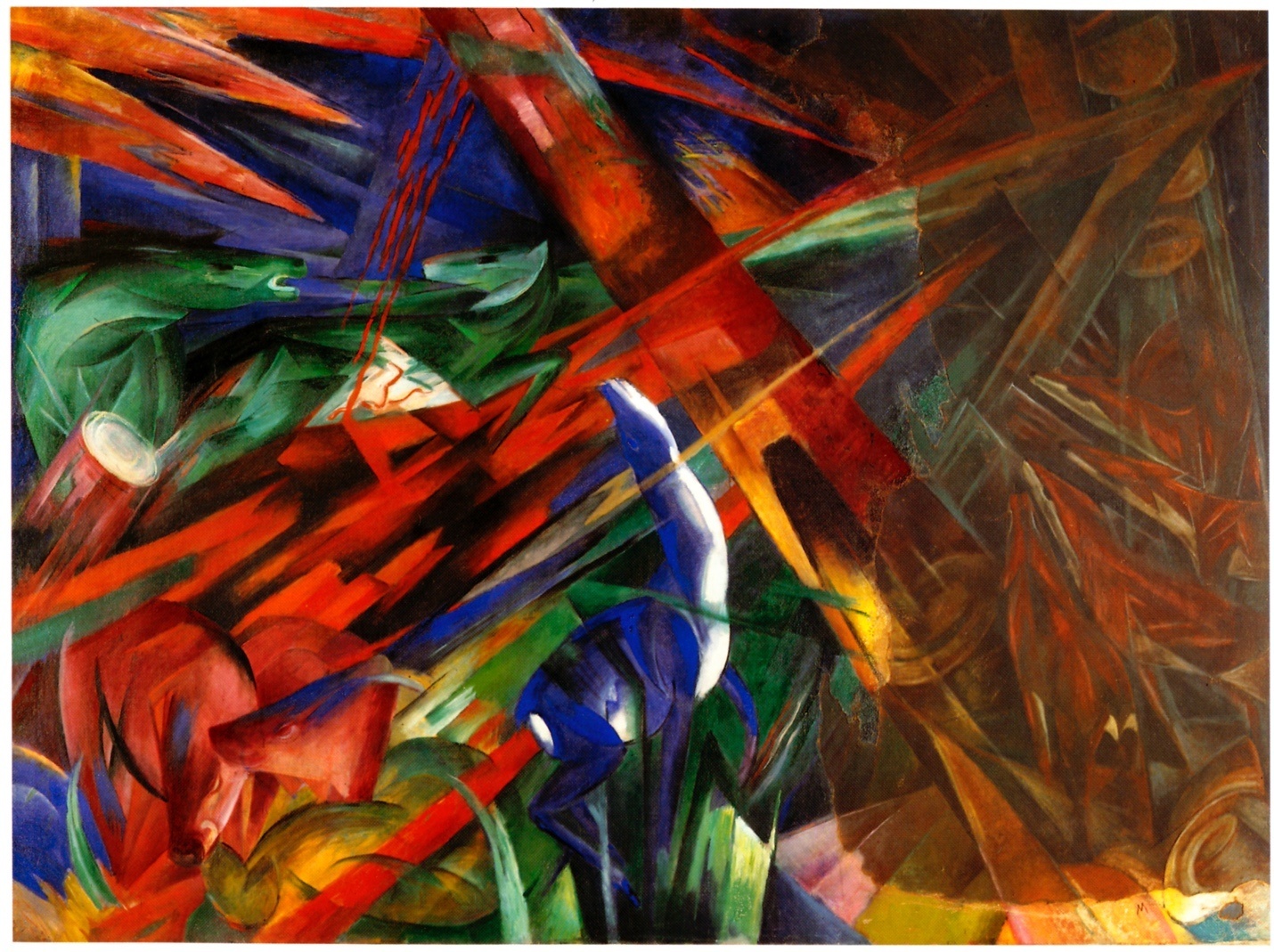
The image above is an exception to Marc’s regular treatment of animals. They were normally presented as being peaceful. According to Mark Dober,
Marc was killed in battle the year after writing this letter. While he seems to have realized that seeing animals as flawless and pure was illusory, he never quite let go of the idea that the war would cleanse his continent in a useful way, bringing changes that would improve society. In that, he died agreeing with the futurists.
Other BlaueRieter Artists
Gabriele Münter was exceptional in her time as she was an accepted member of this artist’s group (and earlier of NKV) and she was female. Women from Germany were not encouraged to attempt a career in the arts. Neither were women from Gabriele’s upper-middle class family. She threw aside tradition and attended the new progressive school Phalanx to study sculpture and wood cut printing. There she met and studied under Vasily Kandinsky. For the next twelve years she lived with him and became the subject of many of his painting. It is unfortunate that in looking for images of her work, one must sift through dozens of Kandinsky paintings that she appeared in before finding anything that was painted by her. Following a period of relative inactivity during the war, and after Kandinsky divorced his wife and married another woman, Münter returned to painting in her early style using simplified forms, and expressive use of line and color.31
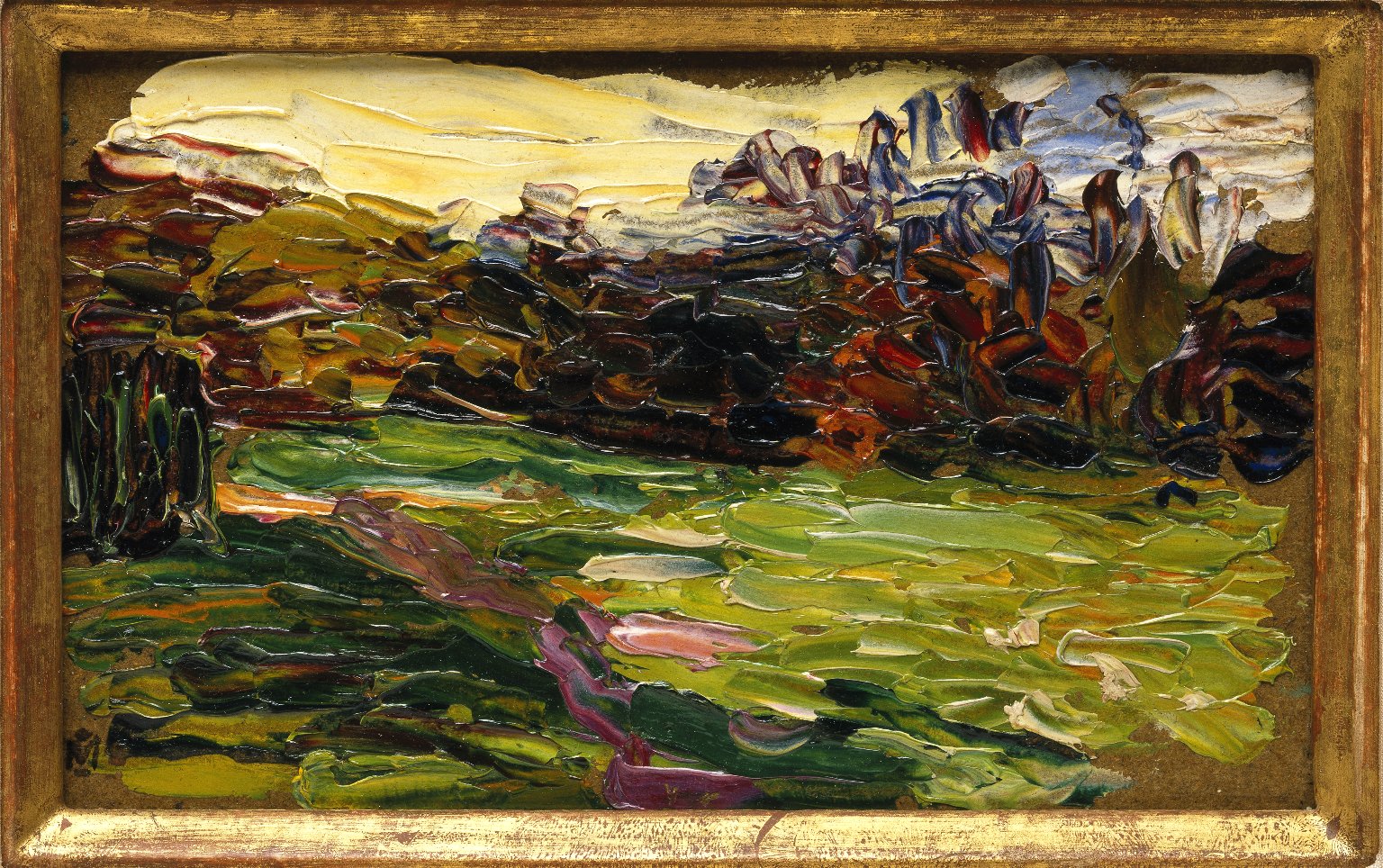
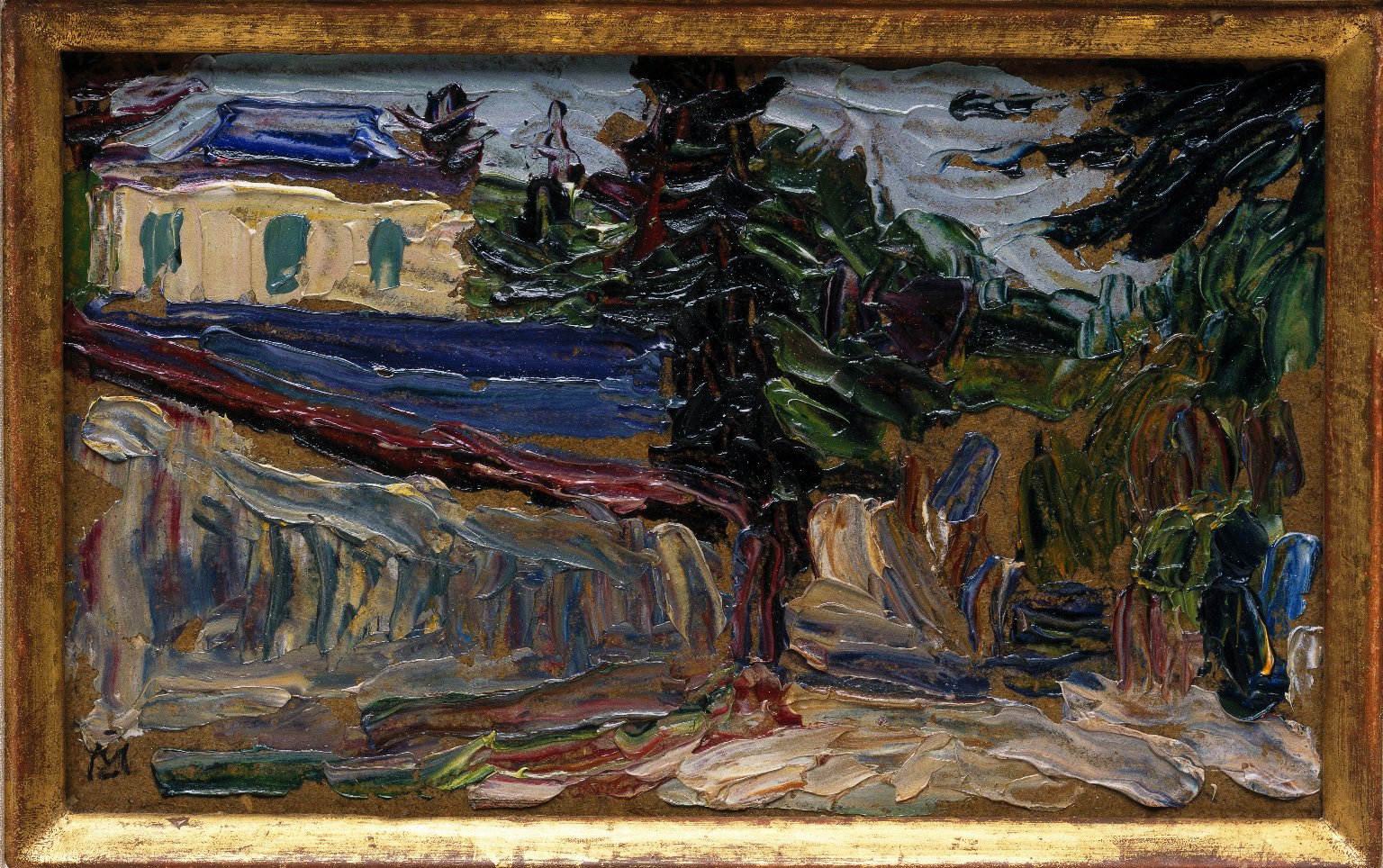
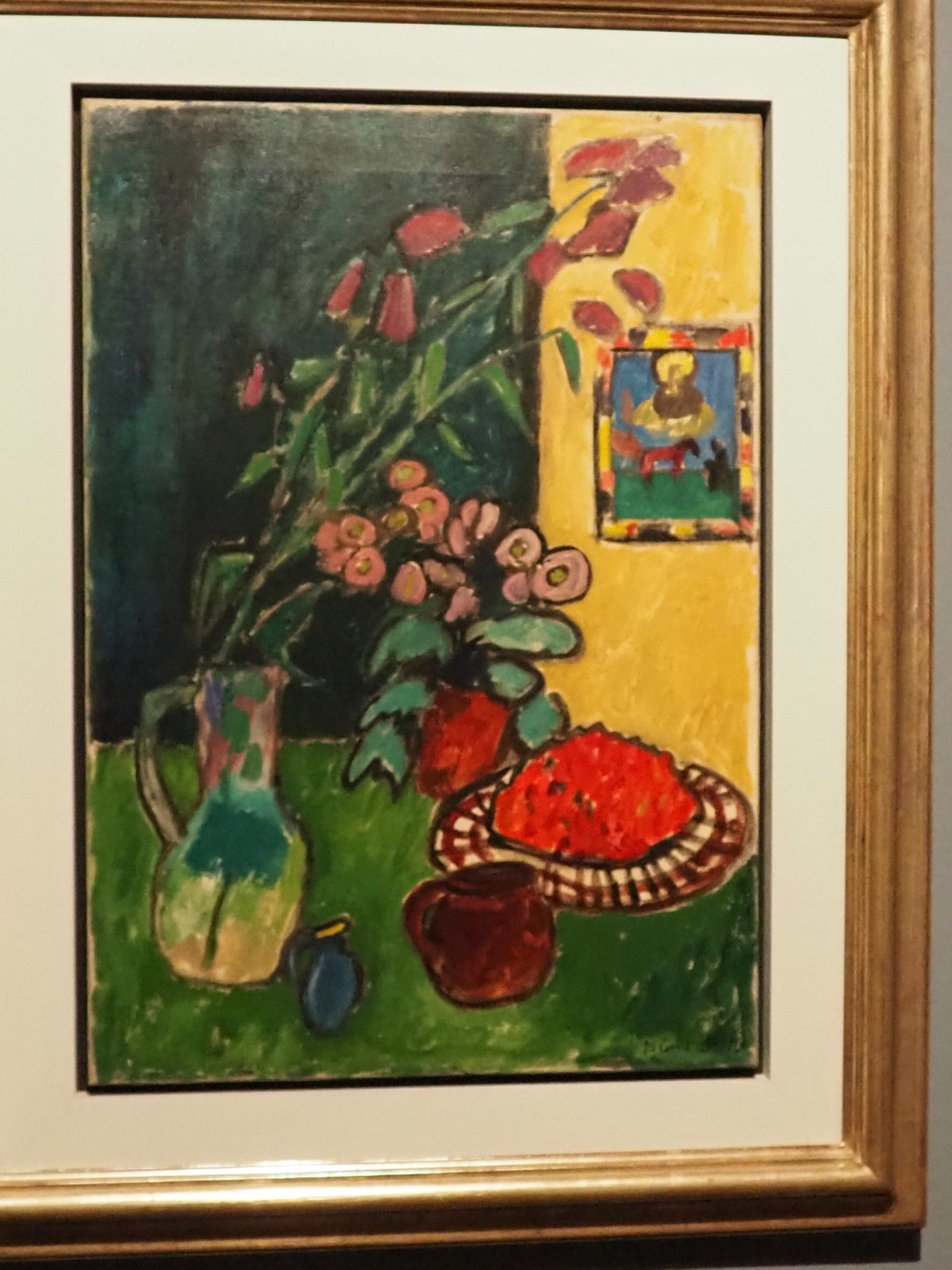
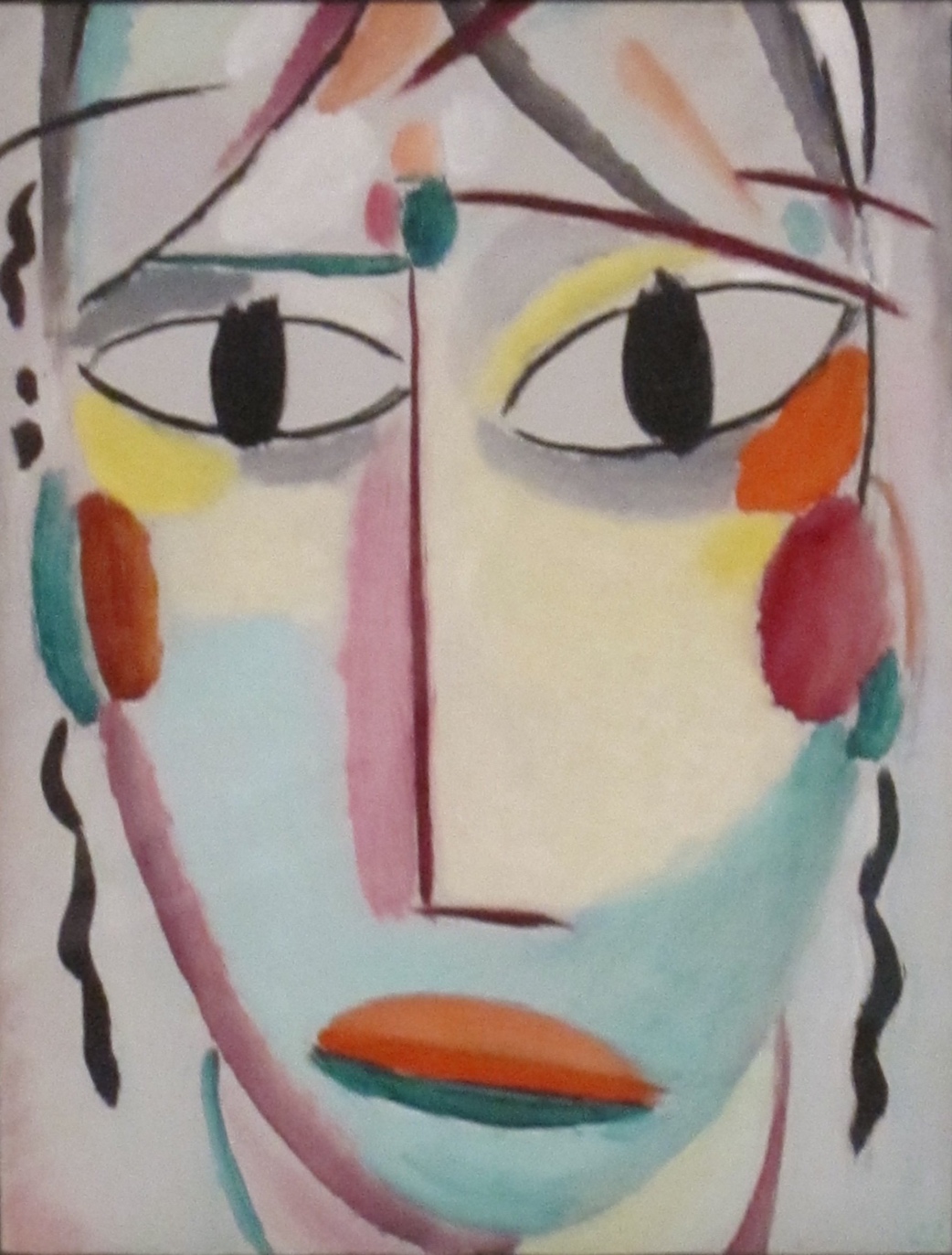
Figure 5.35 is from Alexej Jawlensky’s series, Mystical, also called Abstract Heads. This image was painted after the group was dissolved but is an excellent example of the artist’s mature style. This painting is titled, Savior’s Face, Number 10, Last Look. Note the almost childlike drawing, the simplicity of line and the seemingly random placement of color. Jawlensky made it clear that these images were not drawn from nature. “I sat in my studio and painted, and I did not need Nature to prompt me. It was enough for me to immerse myself in myself, to pray and prepare my soul to attain a religious state.”36
August Macke’s approach is somewhat different. Unlike Jawlensky, he began with what he saw in front of him but, he interpreted rather than imitated it. The painting below is of the ancient Tunisian Islamic city of Kairouan. In the painting he includes both modern and ancient buildings, a camel and a minaret, his reference to spirituality. Notice that Macke paints in watercolor, a medium previously not thought appropriate for high art.

August Macke, like many other members of The Blue Rider, experimented with most of the new emerging styles. It was in his years with the Blue Rider that he honed his craft. His patient wife sat for over 200 portraits as he did so. The 27 year-old artist, like so many of his young compatriots, died in France fighting in World War I. We will never know what he may have been capable of.38

